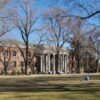This March, a campus publication known for its poetry took a stab at showcasing visual art.
When Brushfire Literature and Arts Journal’s first edition went to the presses in 1950, it didn’t accept original submissions from visual artists. Instead, with only writing contributors, it paid student illustrators to hand-ink drawings tailored to each submitted poem.
It was only after a brief hiatus in the 70s Brushfire started publishing the works of artists and writers in equal measure, said Phoebe Coogle, Brushfire’s current editor-in-chief. Today, the journal’s emphasis is still bent towards writers, but Coogle hopes to balance the disciplines and land more submissions from the world of visual arts.
Now, for the first time, Brushfire has opened a gallery to showcase the art from its contributors included in the most recent editions of the journal.

The gallery’s visitors were greeted with an introduction and two very important editions of Brushfire: its very first and its forthcoming 75th.
“We reached out to our contributors from the last three years, since 2020,and we were like, ‘Would you like to send us the originals that you have, or if you’re a photographer, would you like to send us prints?’ and there was quite a large response from our artists. It kind of came to fruition in that regard,” Coogle said.
The gallery played host to mediums from collage to embroidery on canvas. Some contributors like Lauren Sapperstein, whose ink drawing “Koi the Cat” appeared in the seventy-fourth edition, lent Brushfire’s staff the original work of art, bringing a piece they’d already featured in print onto the wall of McNamara Gallery.
Others used the gallery as an opportunity to showcase their range. Hannah Potts, whose poetry appeared most recently in this year’s seventh-fifth edition, dipped her toe into the visual arts realm with a geography-minded submission. The piece, embroidered on canvas in 2020, re-imagines John Snow’s 1854 map of cholera outbreaks in London — without the outbreaks.
“The gallery — it’s not too focused, we didn’t have any grand theme that people had to follow when they brought in their artwork,” Coogle said.
The only stipulation was that featured artists had to be published in the last three editions, and that one of the four pieces they submitted had to be one that was featured in the journal. But even that’s not always possible, Coogle explained.
“We do have several artists who had sold their originals, and unfortunately couldn’t provide them to us,” Coogle said, “so we kind of played fast and loose with the rules we had set.”
Marking the journal’s history at the start of the gallery were framed prints of its first and seventy-fifth editions’ covers. A volume from each decade since its inception led the viewer towards the work of today’s artists.

Past editions of Brushfire line the gallery’s walls.
Notable details included a copy of the 1952 edition’s third volume, which was clearly hand-lettered, and 2010’s sixty-second edition, whose shadowbox concealed an eye-popping page count. In the years since, it’s fallen to 64 pages, though Brushfire’s staff recently managed to bring it up to 76 in honor of the newest publication.
Like all publications, however, Brushfire only has so much money to spare. Coogle’s ambitions to expand the journal’s presence on campus can sometimes clash with the realities of her staff’s budget.
“I have $200 to host things, and hosting a gallery, frames and shipping costs — that’s already run like $360,” Coogle said. “We’ve eaten through all of our host fees and then some, so it has to come out of operations.”
Operations — like compensating Brushfire’s 5-person staff and paying to print each year’s volumes of the journal — ultimately wind up taking precedence, limiting the journal’s already-strained bandwidth for outreach.
“So if we only have the funds to publish biannually like we almost do in our current situation, it means we’re unable to do all these other cool things,” Coogle said. With more funding, she added, “We would print more, we’d hire more people, we’d host more events.”
Also on the docket might be reviving Brushfire’s zine department, which hosted workshops and curated smaller, more experimental themed publications, with more opportunities for students to submit.
Still, Coogle counts the journal’s stretched year as a success. When she ran for editor-in-chief last summer, she won the position with high expectations.
“I was like, I want to bolster Brushfire’s presence on campus, I want to do a gallery showing, I want to table more. A lot of those things have fallen into place,” Coogle said. “We’re a fairly new team, but we all work together very well, and I’m pretty proud of what we’ve achieved these few semesters.”
The Brushfire gallery closed March 17.
Peregrine Hart can be reached via email at peregrineh@sagebrush.unr.edu or via Twitter @pintofperegrine.









